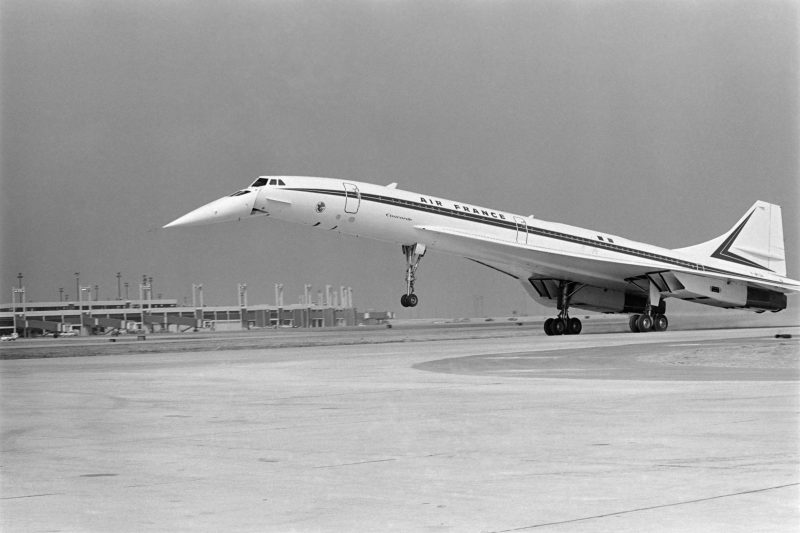Concorde: technical feat, financial fiasco
The Concorde, pictured here in 1973, had a pointed nose which drooped downwards during take-off for better pilot visibility (-, -)
Paris (AFP) – The Concorde airliner first took to the skies 50 years ago promising a revolution in air travel with its technical prowess and supersonic speed.
But just 34 years later and with only 14 planes ever entering commercial passenger service, the Franco-British turbojet was grounded by high costs and still haunted by a major crash in France three years earlier.
Here is some background about the promising but ultimately doomed “great white bird”.
– A dream is airborne –
The first flight of Concorde’s prototype 001 was a successful half-hour test over Toulouse, southern France, on March 2, 1969.
It would take another seven years for the aircraft developed by French company Aerospatiale and the British Aircraft Corporation (precursor of BAE Systems) to begin commercial services.
Its inaugural scheduled passenger flights were on January 21, 1976: the Paris-Rio route operated by Air France and London-Bahrain by British Airways.
– Famous silhouette, innovations –
Among Concorde’s most distinctive features was its pointed nose, which drooped downwards during take-off to allow for better pilot visibility.
Its triangular “delta” wings were also instantly recognisable and offered stability and efficiency.
Innovations born with Concorde advanced aeronautics, including the weight-saving aluminium for the body and the first ever use of electronic controls to replace manual ones.
According to BAE Systems, the estimated final overall cost of developing the Concorde was around 1.6 billion dollars.
– Supersonic speed –
The Concorde and the short-lived Russian Tupolev Tu-144, known as the “Concordski”, are the only passenger airliners to have flown faster than the speed of sound.
While sound travels at around 1,225 kilometres (761 miles) per hour, the Concorde was able to reach a cruising speed of around 2,200 kilometres per hour.
This meant flying time between New York and Paris of three and a half hours, about half that of a regular flight today and 10 times faster than the first non-stop crossing by US aviator Charles Lindbergh in 1927.
But shorter travel times came at a price: a return London-New York ticket in 2003 cost around 8,300 pounds ($11,960).
– Thunderously noisy –
The Concorde was famously loud: a take-off at Washington airport in 1977 measured 119.4 decibels.
By comparison, a clap of thunder hits 120 decibels while the pain threshold for the human ear is around 110.
When the jet broke through the sound barrier, it created a “sonic boom”, a huge crashing noise which led many countries to banish it from flying over their territory.
– Fuel guzzler –
Another black mark was the Concorde’s high fuel consumption. Its four Rolls-Royce/Snecma Olympus 593 engines together guzzled on average 20 tonnes of kerosene per hour of flight and 450 litres (nearly 120 gallons) per minute at take-off.
The fuel consumption per passenger was 14-17 litres for every 100 kilometres travelled — four times more than for an aircraft today.
– Just 14 jets –
Its developers had hoped to sell more than 100 models but in the end just 14 were used commercially between 1976 and 2003, seven each by Air France and British Airways, no other carrier buying in.
Small by contemporary standards, a Concorde could carry between 100 and 144 people.
– Crashing down –
The beginning of the end came in July 2000 when an Air France Concorde crashed near Paris shortly after take-off, killing all 109 people on board and four on the ground.
Both carriers suspended services. Flights resumed after some months but industry confidence was again rocked by the September 2001 plane attacks on New York and Washington.
There were also demands for cheaper and more environmentally friendly travel.
In 2003 the two operators announced they would retire their Concordes, citing poor economic performance, a drop in demand for premium air travel and rising maintenance costs.
Air France’s last commercial Concorde flight was in May 2003; British Airways ended the era in October the same year.
Disclaimer: This story is published from a syndicated feed. Siliconeer does not assume any liability for the above story. Validity of the above story is for 7 Days from original date of publishing. Content copyright AFP.


